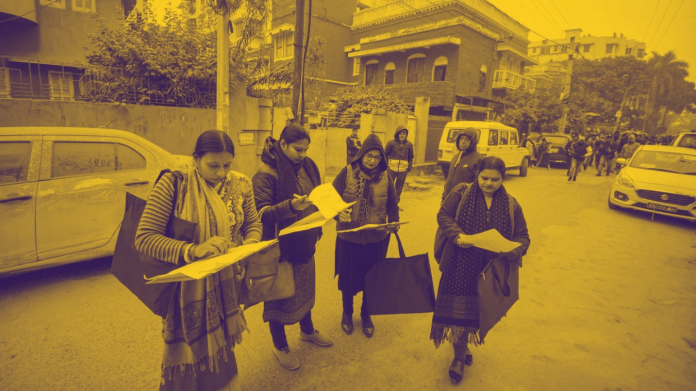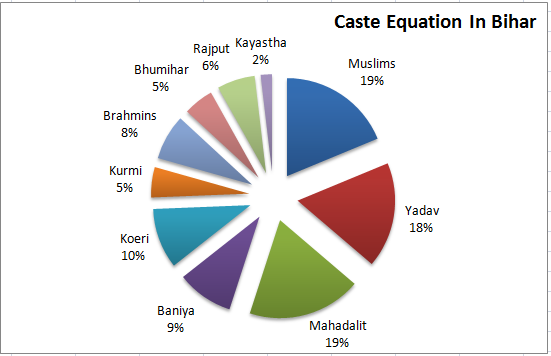
The ongoing caste-based census in Bihar is considered a possible game-changer in policy-making for all the backward castes of the state. Muslims too would be the possible beneficiaries as most of them are considered to be Pasmanda (backward).
Sami Ahmad | TwoCircles.net
PATNA (BIHAR) — The much-hyped caste census in Bihar, which began on January 7, is facing legal and political hurdles even if the backward castes pin their hopes on a new political narrative.
The issue has put the opposition Bharatiya Janata Party (BJP) in a fix as their leaders seem to be opposing each other on this issue.
The caste-based census will be completed by May 2023, and the state government will spend ₹500 crores from its contingency fund for the exercise. The survey is estimated to cover the entire population of Bihar, which is around 14 crores, out of which nearly 17% are Muslim. Though this headcount of all the castes is said to be a possible game changer in policy-making for all the backward castes, Muslims too would be the possible beneficiary as most of them are considered to be Pasmanda (backward).
The Pasmanda population is covered under 27% of reservations and it will benefit from the increase in the reservation after the caste-based survey is completed. There is a consistent demand to include the Pasmanda Muslims in Scheduled Caste (SC) category but this has been outrightly rejected by the current BJP-led government at the centre. Against this backdrop, the caste census is a big hope for this section of society.

It is generally believed that backward castes constitute 55% of the population of Bihar. As of now, the reservation for them is 27%. It is expected that there would be a demand to raise this percentage after the final figures come out. That would mean breaking the ceiling of 50% reservation in government jobs and other opportunities like admission to educational institutions etc. Experts say after validating the quota for EWS (Economically Weaker Section), the Supreme Court has paved the way to breach this ceiling.
Since data related to economic status would be also collected, it is also expected that information about the distribution of resources would also be revealed. That is expected to raise the demand for an equitable distribution of state resources.
The discussion for this headcount was going on for many a month but after clearing the political and administrative hurdles, it is now facing a legal challenge in the Supreme Court after the start of the process of caste-based headcount’s first stage.
On January 11, the Supreme Court of India agreed to give an urgent hearing on January 20 to the petition challenging the Bihar government’s decision to conduct a ‘caste census’. The petitioner, Akhilesh Kumar hails from CM Nitish Kumar’s home district Nalanda, through his advocate Barun Kumar Sinha argued that census, including caste census, comes under the Union government and the state government was wrong in holding that. This PIL was mentioned before the Chief Justice of India D.Y. Chandrachud.
Chief Minister Nitish Kumar answered questions about this petition and tried to clarify that the state government was not conducting any census, rather it was a caste-based survey.
On the political front, Nitish Kumar’s party colleague Lalan Singh, the national president of Janata Dal (United) alleged that the BJP was indirectly sabotaging the process of caste census and asked if the BJP is really in favour of caste census it should then ask the central government to send the attorney general to defend the decision of caste census.
जब राष्ट्रीय स्तर पर जातीय गणना की मांग केंद्र सरकार ने अस्वीकार कर दिया तब 6 महीना तक अड़ंगा लगाने के बाद श्री @NitishKumar जी एवं श्री @yadavtejashwi जी के दबाव में बिहार सरकार को अपने खर्च पर जनहित में जातीय गणना करवाने की सहमति मिली थीं। अब यह कार्य प्रगति पर है….1/3
— Rajiv Ranjan (Lalan) Singh (@LalanSingh_1) January 11, 2023
The reason for questioning the BJP is the conflicting statements of its leaders. While ex-deputy chief minister and BJP’s Rajya Sabha member wished that the BJP should be credited for this headcount, his party colleague and leader of opposition in the Bihar Assembly Vijay Kumar Sinha has alleged that this process of Rs. 500 crores would widen the caste rivalry. Sinha even asked to dump this caste census and instead hold an economic census.
जाति के बजाए, केवल आर्थिक जनगणना करवाकर समाज को तोड़ने से बचाया जा सकता है।
समरस समाज की परिकल्पना कभी भी जाति में बांट कर पूरी नहीं की जा सकती।
क्षेत्रीय पार्टियाँ केवल अपना रोटी सेकना चाहती है, अपना उल्लू सीधा करना चाहती है। pic.twitter.com/XhF9JXfu7C— Vijay Kumar Sinha (@VijayKrSinhaBih) January 7, 2023
Former deputy chief minister Sushil Kumar Modi was particular in stating that credit for this caste headcount should not go to the current chief minister Tejashwi Yadav as he was not in the government when the Bihar cabinet decided for caste headcount. Experts say that the BJP see Tejashwi as a possible beneficiary of the outcomes of the caste census, so he is being targeted. It may be recalled that the caste census was one of the issues that contributed to the reunion of Lalu Prasad’s RJD and Nitish’s JD (U) which kicked out the BJP from the government in August last year.
Ali Anwar, president of All India Pasmanda Muslim Mahaz and two times Rajya Sabha member told TwoCircles.net that caste base headcount is the only solution to the menace of communal hatred.
Anwar has written a booklet titled ‘Sampradayik Dhruvikaran Ka Yahi Ilaj, Jati Janganana Ke Liye Ho Jao Taiyar’ meaning ‘Get ready for Caste Census, This is The Solution to Communal Polarisation’. He also coined the slogan ‘Dalit-Pichhda Ek Saman, Hindu ho Ya Musalman.’
He claimed that BJP is afraid of the caste census as “it will fail their agenda of communal polarization” and that is why they are opposed to it.
“Apart from getting benefits of an increased proportion of reservation, Muslims, and all the citizens are going to get a communal hatred-free environment by the results of this caste census,” he added.
Sami Ahmad is a journalist based in Patna, Bihar. He tweets at @samipkb

